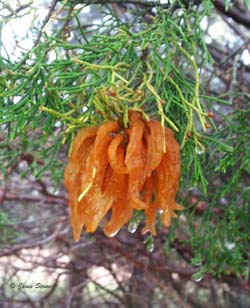Manassas National Battlefield Park, Manassas, VA
(Fresh teliohorns on Eastern Redcedar (Juniperus virginiana))

[ click on any image below to see larger version ]
Family: Pucciniaceae
Mid-Atlantic bloom time: mid Spring on Eastern Redcedar
This fungus affects apple (Malus) trees in alternate years to Eastern Redcedar (Juniperus virginiana) trees. The two species of trees usually must be within a mile of each other. Most people will notice the strange orange form on cedar trees in wet conditions. On apple trees (also hawthorn or quice), it forms spots on the leaves.
According to a USDA Forest Service webpage (2014),
"This particular rust produces four kinds of spores: basidiospores, teliospores, spermatia, and aeciospores. Teliospores are produce[sic] on gelatinous telial horns (see photo) which originate from golf ball-like growths on redcedars or other junipers. Telial horns emerge following a warm spring rain in April to May. Five to seven sets of teliohorns can be produced during spring, one after each warm rain. Teliospores germinate to form basidia. Basidia produce basidiospores that are released into the air, blown two to three miles potentially to an apple or hawthorn leaf or fruit. They germinate and form a yellow to orange spot on the leaf or fruit.... These spots produce spermogonia that in turn produce spermatia. The spermatia are released into a sticky liquid attractive to many insects. As insects carry spermatia from one spot to the next fertilization takes place. The fungus grows through the leaf and produce aecia on the underside of the leaf.... The aecia produce aeciospores that are windblown back to the redcedars. They then germinate and start the formation of galls that in the following year will produce telial horns to start the process over again."
|
30 April 2014
Manassas National Battlefield Park, Manassas, VA (Fresh teliohorns on Eastern Redcedar (Juniperus virginiana)) 
|